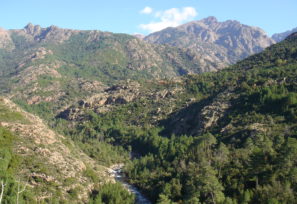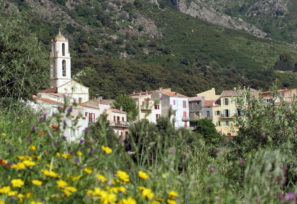Lunghignano… as close as possible to Montegrosso
Between Montemaggiore and Cassano, Lunghignano is proud to welcome you at the foot of Montegrosso, the great mountain of this area. This mountain is so great, that its name was given to the municipality which today groups together the three villages.
This gem of Balagne was founded in the Middle Ages around the 18th-century Baroque-style church. You will be eager to find out more about this place with the sculpted doors guarding the entrance to the the very original old houses.
On your way, you will most probably bump into one of the icons of the village… Nicolas’ donkey! It always draws the attention of passers by. It is probably there to guide people towards an old oil mill, U Fragnu, which has now been reconverted into a delicatessan. You can’t miss it!
Don’t forget to stop by the village square and have a chat with the local petanque players who gather there, before continuing your discovery of the Balagne villages. You are pretty much guaranteed to find the locals at this square, especially in the afternoons.
Finally, if you are here in August, you will most certainly enjoy the friendly atmosphere of the Saint Vitus celebration, the protector of the village.
Old houses and sculpted doors…
The village of Lunghignano is overlooked by the Capu di Bestia, and is situated half way up a slope and on the mountainside. Visitors to this village are always drawn in by the old houses, often with beautiful sculpted doors.
300 m. to the East, on the heights of the village, once stood the fort of Pilone and the ancient medieval village, which was abandoned in the 17th century.
A bit of history…
In the Middle Ages, Lunghignano was an independent town with its own land covering 4 km², before later merging with the neighbouring villages of Montemaggiore and Cassano. Then, it was decided to unite the three villages in a single municipality. Today, it is known as Montegrosso.
In around 1467, Ambrosgino de Lunghignanu was given the title of Governor by the Duke of Milan, one of the lords of Corsica. However, he was subjected to the tyranny of a large number of “caporali“; and he also had to deal with a general situation of complete chaos. Due to all of this, he finally decided to leave his town and placed himself in self-imposed exile in Italy.
Did you know?
In the hamlet of Lurgugliu, there is a flat stone with a circumference of around 1m. According to oral tradition, this was used for the practice of torture, and maybe even sacrifices.
Lunghignano in pictures
Vincent, Last summer, I was on my way to Cateri, via Montemaggiore. I went the wrong way and ended up in Lunghignanoand stopped off in Fragnu to ask for directions. I spent a long time talking to the owner. The time flew by and I was thrilled to have gone the wrong way and ended up here!








